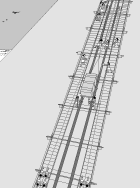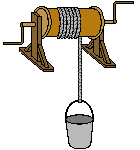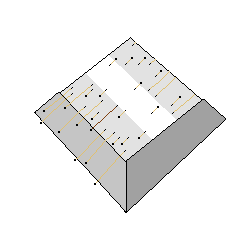Theories of pyramid ramp systems refuted
The ramp models
Many construction techniques for the Egyptian pyramids have been suggested.
On this page we take a good look at the proposed transport ramps and machines:
Rope roll - 5 requirements
- Winding ramp - Straight-on ramp
- Zigzag ramp - Internal ramp
- Combination ramp model - Up
two pyramid flanks - Machines - Using
horses or oxen - What has been found? - Sources
You want to know about the main problems or drawbacks of all ramp systems?
![]() Theories of pyramid ramp systems disproved
Theories of pyramid ramp systems disproved
 Franz Löhner's rope roll
Franz Löhner's rope roll
 On
this website we propose, that the stones were tied onto sledges and pulled
up on wooden tracks which were anchored on the pyramid flank. Too achieve
this, you have to use so called rope roll, a simple device
which turns the ropes attached to the sledge around and back down. Now
the hauling teams can walk down on both sides of the track instead of
walking up ahead of the sledge. By walking down they pull the sledge with
the stone attached to it up the tracks.
On
this website we propose, that the stones were tied onto sledges and pulled
up on wooden tracks which were anchored on the pyramid flank. Too achieve
this, you have to use so called rope roll, a simple device
which turns the ropes attached to the sledge around and back down. Now
the hauling teams can walk down on both sides of the track instead of
walking up ahead of the sledge. By walking down they pull the sledge with
the stone attached to it up the tracks.
Because the haulers can add their own weight to their strength to pull the stone up, it is possible to accomplish this on the 52°-slope of the pyramid flank. Without the rope roll to turn the rope, it would not be possible.
For more details, please click on the illustrations on the left and look
at the following pages:
![]() Löhner's rope roll
Löhner's rope roll
![]() Transport up the pyramid flank with Löhner's
rope roll
Transport up the pyramid flank with Löhner's
rope roll
![]() Overview pyramid building
Overview pyramid building
 Five requirements that every pyramid construction theory should fulfill
Five requirements that every pyramid construction theory should fulfill
Franz Löhner stipulates that any method or theory for pyramid construction should fulfill the following 5 requirements, otherwise it should be rejected!
1. A solution that is as simple as possible using a technology
that is as simple as possible (Occam's razor)
2. Continuity in technical matters and craftsmanship
3. Verification through pictures and/or text
4. Technology keeping with the time and culture
5. The supposed technique / method must really be a solution
 Winding or spiral ramp
Winding or spiral ramp
This model is the one, most Egyptologists propose.
To evaluate this model, you have to keep in mind, that one stone
block per minute had to be transported up the pyramid. If you
stop the work often, so you can lengthen or raise the ramp, then you will
have to calculate with an even faster cycle!
![]() Numbers and figures of the Cheops-pyramid
(pyramid of Khufu) (output)
Numbers and figures of the Cheops-pyramid
(pyramid of Khufu) (output)
Please note, that most of these illustrations show ramps with inclinations
of more than 10°. Our calculations show, that for inclinations of
5° you need 53 haulers or more and with an inclinations of 10°
already 427 haulers (with 15kp force exterted by each man you need 37
/ 136 hauler) are needed to pull up a 2.5 tons stone block (unless you
use Löhner's rope roll, then you need
much less haulers).
![]() Calculating the force and kinetic coefficient
of friction necessary
Calculating the force and kinetic coefficient
of friction necessary
|
 The straight-on ramp
The straight-on ramp
|
 Zigzag ramp
Zigzag ramp
|
 Internal ramp
Internal ramp
|
 Combination ramp model
Combination ramp model
|
 Going up the two pyramid flanks
Going up the two pyramid flanks
This model is similar to Franz Löhner's model but should not be confused with it! The model also proposes to use the angled faces of the pyramid structure itself to haul up the stones. But without using a rope roll, major problems develop after a very short time!
|
 Machines
Machines
Machines such as the capstan, the shaduf, the lifting jack, the gantry crane and hoists have been suggested to aid building the pyramid.
A shaduf is an ancient water-raising device used by
ancient Egyptians. To be able to use them for constructing the pyramid,
wooden towers would have be constructed and moved up the stepped sides
of the pyramid as construction proceeds. However the proposal that some
form of shaduf was used has to be deemed an impractical solution because
they can't lift or move enough stones (calculations show one 2.5-ton stone
per minute) in the time available. We also doubt, that a wooden beam alone
could carry that much weight.
![]() Shaduf (or shadoof): Wikipedia
/ Egyptian
painting / photo
/ used on the pyramid
flank
Shaduf (or shadoof): Wikipedia
/ Egyptian
painting / photo
/ used on the pyramid
flank
Lifting jack: The lifting jack uses a short pole and several short planks. A stone block is levered using the pole at one side and the plank is inserted to keep that side of the block up. Then the opposite side of the block is levered in a similar manner and again a plank inserted. This process can be repeated until the desired elevation is achieved. By the time the pyramid of Khufu had reached half its completed height, some fifteen hundred separate jacking actions, together with approximately eighty horizontal transfers, would have had to be undertaken for a single stone block [2], so it could reach the appropriate height - way too much time and effort - an impractical solution!
 The
capstan consists of a wooden drum or barrel mounted on
an axle. So called handspikes, are mounted or inserted through holes on
the top and are used to turn the capstan. It is used on ships to lift
the anchor or heavy loads. However the capstan is not stable enough to
lift the amount of stones needed for the pyramid. And since it uses an
axle like a wheel it was probably not known during the time, when the
pyramids were built. However later during the Late Period of ancient Egypt,
water drawing machines were used, where oxen pulled on a large horizontally
mounted wheel (Sakije) [3] similar to the capstan.
The
capstan consists of a wooden drum or barrel mounted on
an axle. So called handspikes, are mounted or inserted through holes on
the top and are used to turn the capstan. It is used on ships to lift
the anchor or heavy loads. However the capstan is not stable enough to
lift the amount of stones needed for the pyramid. And since it uses an
axle like a wheel it was probably not known during the time, when the
pyramids were built. However later during the Late Period of ancient Egypt,
water drawing machines were used, where oxen pulled on a large horizontally
mounted wheel (Sakije) [3] similar to the capstan.
![]() Wikipedia Capstan
Wikipedia Capstan
 The
winch should not to be confused with Löhner's rope
roll. A winch is a mechanical device that is used to wind up a rope. It
consists of a spool and attached cranks. Winches are often used in ships
to hoist up the anchor or to lift up buckets with water from deep water
wells. The rope is wound around a cylindrical drum.
The
winch should not to be confused with Löhner's rope
roll. A winch is a mechanical device that is used to wind up a rope. It
consists of a spool and attached cranks. Winches are often used in ships
to hoist up the anchor or to lift up buckets with water from deep water
wells. The rope is wound around a cylindrical drum.
The ancient Egyptians probably didn't know this device until the wheel
was introduced to Egypt. The spool or drum is turning around a central
axis like a wheel. Axles are not very stable and likely to break if the
load is too heavy. Löhner's rope roll has
a diameter of 14cm and - more important - only a piece of about 10cm is
used to deflect the rope. A short but thick piece of wood is much more
stable than a think and long piece like in a wheel.
![]() Wikipedia Winch
Wikipedia Winch
The pulley and the gantry crane or
other hoists also have to be discarded, because the basic building block,
the wheel, was unknown to the Egyptians. Other devices using cogwheels
or steel hooks have been suggested, but these machines were not known
during the area of the pyramid builders.
![]() Wikipedia Pulley
/ Gantry
crane
Wikipedia Pulley
/ Gantry
crane
 Using horses or oxen and wheels
Using horses or oxen and wheels

Some people suggest, that horses or oxen could have hauled
the sledges (or wagons) with the stones up the ramps. The first known
painting of an oxen hauling a sledge dates from 1000 years after Khufu
built his pyramid. For heavy loads, a sledge is anyway much better, wagons
needs roads and an animal to pull it. Horses only reached Egypt around
1700 before Christ, when Hyksos invaded Egypt. The wheel was not known
at that time either. Anyway, wagons with an axle were not stable enough
to transport heavy stones - a frieze
from Nineveh shows a statue on a sledge. A wagon just behind it is
only loaded with building material.
![]() Transporting the stone blocks using a sledge
on tracks
Transporting the stone blocks using a sledge
on tracks
 What has been found?
What has been found?
Only small, embankment-like structures have been discovered on the Giza plateau. Actually some smaller ramps were found - one on the southern side of the pyramid of Medûm (Meidum), which was 5m wide (adobe bricks) and at the pyramid of Sesostris I in Lisht there is a ramp of about 50m length. But these ramps are much smaller than the huge construction ramps suggested by the Egyptologists, more like transport roads or auxiliary ramps.
Facts contradicting all models
All ramps get smaller when they reach the upper portion of the pyramid.
So it is of great importance, that when you get higher up you only use
smaller and lighter stones. With a ramp you would expect, that the size
of the stones would decrease steadily as you get higher. It is interesting,
that this is not the case in the pyramid of Khufu! On the contrary you
find thicker stone layers even very high up - on 69m, 75m and on 89m.
This fact is inconsistent with the proposed ramps but corroborates the
use of Franz Löhner's rope rolls and the installation of rope-roll
stations also high up on the pyramid flank.
![]() Stone courses of the Pyramid of Khufu
Stone courses of the Pyramid of Khufu
![]() Transport up the pyramid flank with Löhner's
rope roll
Transport up the pyramid flank with Löhner's
rope roll
There is a dearth of conclusive archaeological evidence supporting and several facts contradicting the theory that massive ramps were used for the construction of the pyramids. For winding ramps there is no archaeological record at all that indicates the use of one, the depictions of ramps on wall paintings or papyrus generally show straight ones which lead up to a wall.
 Sources
Sources
[1] Papyrus of Anastasi: There is a ramp to be made of 730
cubits, with a breadth of 55 cubits, consisting of 120 compartments, filled
with reeds and beams, with a height of 60 cubits at its summit, its middle
of 30 cubits... (inclination of ramp = 9.9°)
[2] J.F. Edwards Building the Great
Pyramid
[3] O. Riedl Die Maschinen des Herodots
You want to know about the main problems or drawbacks of all
ramp systems?
![]() Theories of pyramid ramp systems disproved
Theories of pyramid ramp systems disproved
| Copyright 2006: |
Franz Löhner www.cheops-pyramide.ch | |
| Concept and Design, English Texts: |
Teresa (Zubi) Zuberbühler www.starfish.ch |
 With
this two-sided approach the stones are attached to long ropes and
hauled up the lateral surface of the pyramid by hauler teams operating
on the flat plateau of the pyramid. These teams walk horizontally
across the plateau while hauling, until the stone reaches the edge
of the pyramid. Then the stones are hauled to the construction area.
With
this two-sided approach the stones are attached to long ropes and
hauled up the lateral surface of the pyramid by hauler teams operating
on the flat plateau of the pyramid. These teams walk horizontally
across the plateau while hauling, until the stone reaches the edge
of the pyramid. Then the stones are hauled to the construction area.